Nature Conservation 2020 — 25. 3. 2020 — On Nature in the Czech Republic — Print article in pdf
Dirt roads
– biodiversity islets within an agricultural desert on the example of Pálava Protected Landscape Are

The impact of industrialised agriculture on biodiversity and landscape ‘condition’ is presently a frequent topic of discussion with experts from various scientific fields. The media and the public are also very interested in the issue, particularly in connection with the drought and generally the ability of our landscape to retain the little moisture which our nature currently endows us with. This contribution will however not deal with rapeseed and maize fields, but with that what separates (or at least should separate) blocks of intensively farmed fields, i.e. increasingly rare dirt roads.
The dense network of dirt roads, which has intersected our landscape since ancient times, has not only served man and his needs. It has also been a migration corridor and a permanent habitat of many animal and plant species. Particularly insects associated with bare and sparsely vegetated soil have found here exactly what they need for their development. The margins of dirt roads, with transitions to arable land, have thus provided refuge to all sorts of weed species, many of which we regard (despite negative connotations associated with the word ‘weed’) as rare and disappearing species of our flora today. Bouquets of field flowers, overflowing with colours and shapes, and evoking in people feelings of harmony and unity with nature, used to be a frequent motif in paintings and are a basic motif in ornaments in South Moravian folk art. However, an artist would hardly find inspiration in the present agricultural landscape. Red poppies, blue cornflowers, pink corncockles and white chamomiles are replaced by uniform verdure, passing into the equally uniform yellow of ripening corn or flowering rapeseed. That dense network of dirt roads has disappeared and also the diversity accompanying it has gone. Despite, or all the more, remaining unpaved dirt roads are important – for the landscape itself as well as for species diversity.
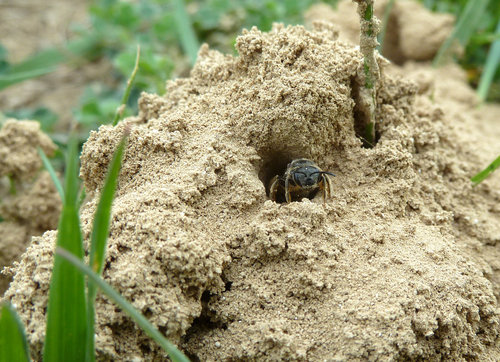
Lasioglossum marginatum workers. Photo Pavel Dedek
The migration permeability of our landscape is still declining. This is not only due to linear infrastructure like roads and motorways, most often mentioned in this context. Dense, dark forests and vast land blocks are much more involved in the loss of connectivity. With the isolation of plant and animal populations inhabiting the last remnants of suitable environment, also the probability of their extinction is growing.
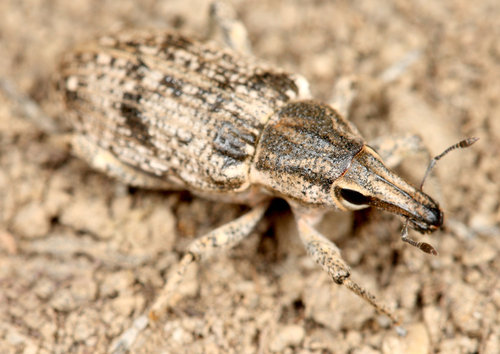
Asproparthenis punctiventris, once a dreaded pest. Photo Filip Trnka
Maya the Bee and her relatives
Stacks of paper have been written about the importance of bees to humans. A great majority of these works, however, concentrate on a single species, the honey bee (Apis mellifera), while more than 1,300 species of various solitary bees and wasps (included in the group of so-called sting hymenoptera) live in our country. It is a rich group of various shapes, colours and life strategies. A large part of them is bound to bare or just sparsely vegetated soil (not poisoned by pesticides). Their association with bare substrate is often reflected in the vernacular names of bees and wasps, like mining bee or mason bee. All these species take part in the pollination of plants. Some are specialised in particular plant species or genera; others take all that abounds in the landscape at a particular moment. In the past, varied and richly flowering field margins offered sufficient nectar and pollen and a dirt road provided bare soil to build nests.
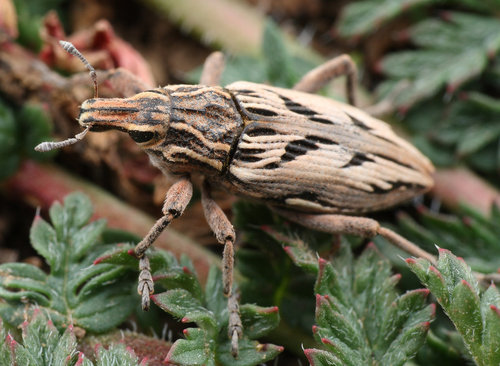
The weevil Coniocleonus nigrosuturatus reappeared in the Czech Republic
after 40 years. Photo Filip Trnka
Changes in the structure of the agricultural landscape have meant a significant deterioration in the conditions for solitary bees and wasps. Easily accessible food as well as suitable places for nest building have declined. The remaining unpaved dirt roads in Pálava, however, still host interesting hymenopterous species, although there are undoubtedly not so many as in the past. One of the most remarkable ones is sweat bee Lasioglossum marginatum, which is not large or colourful, but their nests and the high activity around them can hardly be missed. Although sweat bees (Halictidae family) are solitary bees, the developmental cycle of their nests of this species is different from all other members of the family and approaches that of true social insects. The development of a nest takes a full six years and the number of workers in the nest increases year by year. Drones and fertile females appear only in the last year. They then copulate and the fertilised females fly away to found a new nest. Other solitary bees and wasps have a much simpler development. A fertilised female builds a nest (e.g. a long corridor with chambers in the ground), supplies the different chambers with food (mainly pollen for bees and e.g. paralysed spiders, caterpillars etc. for wasps), lays one egg in each chamber, secures the nest against intruders, and dies.

Black oil-beetle (Meloe proscarabaeus). Photo Pavel Dedek
The much larger and colourful Scolia hirta can be observed on flowering field eryngo (Eryngium campestre). Belonging to the wasps, their larvae demand ‘meaty’ food. It searches for larvae of cockchafers (e.g. scarabs of the genus Anisoplia). When it finds a cockchafer grub, it stings just enough much poison into it as to paralyse but not to kill the larva. It lays a single egg on the paralysed grub, from which a larva hatches that will live from the tissue of the immobilised grub for the whole time until it becomes a pupa.
Members of the spider-hunting wasp family (Pompilidae) choose a similar strategy. They like visiting the flat inflorescences of plants of the carrot family and are not rare along well-preserved dirt roads. They build their nests on bare soil and supply the chambers with paralysed spiders.
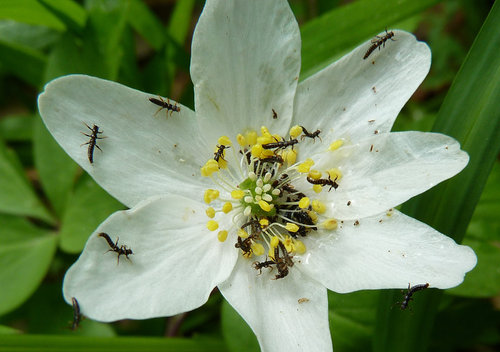
Triungulins – larvae of violet oil-beetle (Meloe violaceus). Photo Pavel Dedek
Solitary hymenopterous species often ‘suffer’ from nest parasites. Nearly every thrifty bee or wasp species has some thief wanting to obtain some food without work. They let the honest bee or wasp build a nest, wait until the host species fills it with sufficient food and then, inconspicuously, just as a cuckoo, puts its own egg into the alien nest. The described thief scenario is just one of numerous possibly strategies.
An example of such an unwanted coexistence on one of the Pálava dirt roads is the rare sweat bee Systropha curvicornis, whose males have typical curved antenna tips. These bees nest on bare sand or sandy loam and often collect pollen and nectar on field bindweed (Convolvulus arvensis). The roughly 1 cm large bee digs an up to 50 cm deep corridor with a foetal chamber at the end. Its ‘personal thief’ is the bee Biastes brevicornis. It has a ‘prying’ flight, searching for nests of its victims. Also these bees like the flowers of field bindweed, where host and parasite meet each other. However, they do not want to work and so rather rob the nests of the poor sweat bee. Both species are included the Czech Red list of invertebrates. Systropha curvicornis used to be quite common and distributed throughout the Czech Republic, but has disappeared from many sites and is now relatively common only in the south of Moravia. Biastes brevicornis is a distinctly thermophilous bee occurring only at South Moravian localities.
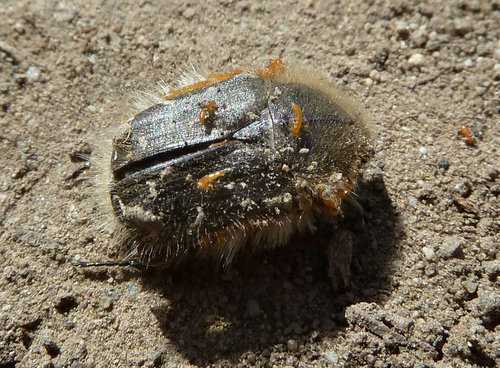
Fatal mistake by triungulins: instead of solitary bees, the larvae ‘board’ a chafer
(Tropinota hirta). Photo Pavel Dedek
Weevils – easy and fast from dreaded pests to dying species
Weevils of the Cleonini tribe are another significant group of inhabitants of dirt roads and other disturbed habitats with sufficient bare soil. These are rather large and particularly attractive beetles with an interesting history. A vast majority of species have undergone a drastic decline in the last half century and some of them have gone extinct.
An interesting case is formed by Asproparthenis punctiventris. This used to be a dreaded pest of rapeseed. The fight against it was so successful that this weevil is now a rare species threatened with extinction. Unfortunately, many other weevil species met a similar fate, even though they were not actively controlled. Changes in the landscape structure were sufficient: a decline in grazing, elimination of baulks, disappearance of fallow land, and paving of dirt roads.
The most interesting species of dirt roads in Pálava include Pseudocleonus cinereus, Bothynoderes affinis and Mecaspis alternans. While encountering these beetles in nature reserves of Pálava Protected Landscape Area* is a rare event, dozens of these beetles can be observed on dirt roads within a few hours. In 2019, the author of this article managed to discover Coniocleonus nigrosuturatus, a species which had been unaccounted for in the Czech Republic for more than 40 years (last seen in 1978), on two dirt roads. Unpaved dirt roads are, as it seems, absolutely essential for this threatened group of beetles.
Blister beetles
These beetles are a group which has been most affected by extinction over the past century. Out of the total number of blister beetles (24 species) 11 have gone extinct, another six are on the brink of extinction and only three can be regarded to be relatively safe. All the above-mentioned factors have contributed to this terrible decline: intensification of agriculture, decline in landscape variety, the use of chemicals, yet completed by the dependence of blister beetles on solitary bees, in whose nests not only hymenopterous relatives parasitise, but also many other insect species, including blister beetles.
After a blister beetle successfully mates, it lays thousands of eggs in the ground, from which small, slender and very mobile larvae called triungulins hatch. These larvae quickly search for the nearest flowering plant and settle right in the flowers, in great numbers. However, they do not head here for food, but wait for transport. Larvae of blister beetles are parasites in solitary bee nests, which they reach by massively climbing on a pollinator which has landed on the flower and then takes the parasites home. This is however a kind of lottery. The larvae get on any insect which sits on the flower and by far not all taxi rides end there where the larva needs. Also butterflies, flies and other insects visit flowers, so only a small part of the larvae reach their destination and the remainder dies (hence also the seemingly unnecessary overproduction of eggs). The luckiest in the solitary bee nest undergo a complete reconstruction of their bodies. After the slender larva eliminates the bee foetus and occupies a honey chamber with accumulated food, it transforms into a barrel-shaped immobile larva which further feasts on the food which the bee has collected for its offspring. After it has used up all the honey, the larva transforms into another untypical stage, a pseudopupa, and hibernates this way. In spring, the larva transforms again, from a pseudopupa into a legless larva, which can then turn into a true pupa. This is followed by the last, stormiest stage of development: in the pupa, the larva body dissolves into a pulpous substance which turns into a mature blister beetle, which digs itself out of the underground bee nest to the surface. And the entire cycle can then start again. Blister beetles thus need solitary bees. And the bees in their turn need non-poisoned bare soil and flowering plants. No wonder our blister beetles are not doing well.
Conclusion
Unpaved dirt roads are habitats and migration corridors, the importance of which is still increasing in the present altered agricultural landscape. This landscape element is essential for at least the biodiversity which has remained. This is not only ‘weeds’, bees, weevils and blister beetles. A sound dirt road is full of small predatory ground beetles, wolf spiders, darkling beetles, tiger beetles and hundreds of other invertebrates. Insects provide people and ecosystems with a whole range of services for which they request no other ‘salary’ than living space. Hundreds of species of hymenoptera, butterflies, beetles and other invertebrates are involved in plant pollination, others in decomposition of dead matter or dung, returning nutrients to the soil. Insects also form the food base for countless birds, amphibians, reptiles and mammals.
Nevertheless, we still encounter efforts to pave dirt roads (most often with asphalt). This trend, together with industrialised agriculture, has the potential to become the definitive gravedigger of the diversity and functionality of our landscape.
Not many remaining landscape structures meet the definition of ‘significant landscape element’ and the role of ‘territorial system of ecological stability’ better than exactly unpaved dirt roads do. Despite, many dirt roads only exist on paper (but are in fact sown and farmed as arable land) and the remaining ones are systematically eliminated by paving them with asphalt or other materials.
Long discussions can be held on the effectiveness of this. An asphalt road looks good, at least in the beginning. However, it is evident from asphalt roads built not long ago what these paved roads will look like after a few years of being used by increasingly heavy agricultural machinery. The driveability of broken asphalt roads with ruts and torn roadsides is really far from ideal for cyclists, in-line skaters and even a personal car. A new asphalt road is free of costs thanks to subsidies, but their future maintenance will need finances. And we really have to reach deep into our pockets for securing constant repairs.
In places where paving is truly indispensable, more suitable alternatives to asphalt exist. An example is a double-track dirt road, consisting of two strips (e.g. using prefabricated concrete elements) with a free space between them. This was realised in the Nymburk region (https://www.spucr.cz/aktuality-z-kraju/archiv/stredocesky/vystavba-kolejovych-polnich-cest-na-nymbursku.html) and shows that the National Land Registry (NLR) can also build such roads. On its website, the NLR states among others the following on this topic: “For practical reasons, we utilise track paving in the realisation of some subordinate dirt roads. Its advantage is lower costs, possible application on routes with steep slopes, minimal maintenance, high durability, and better integration in the landscape”. However, neither this paving method is ideal. Without regular traversing, the space between the concrete tracks will grow over with vegetation, so that the necessary spots with bare soil disappear.
* A positive exception in this respect is the recently designated Na cvičišti Nature Monument, which is managed by means of intensive disturbance and thus provides sufficient disturbed habitats with bare and sparsely vegetated soil.
A list of the most significant species recorded
by the author on a single dirt road below Svatý kopeček Nature Reserve is attached to the web version of the article on www.casopis.ochranaprirody.cz

